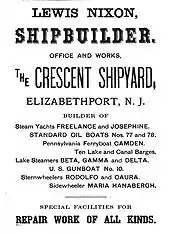
Crescent Shipyard, located on Newark Bay in Elizabeth, New Jersey, built a number of ships for the United States Navy and allied nations as well during their production run, which lasted about ten years while under the Crescent name and banner. Production of these ships began before the Spanish–American War and occurred far before the outbreak of World War I. Arthur Leopold Busch, a recent emigre from Great Britain, started the yard with former Navy Lt. Lewis Nixon in January 1895. Both men previously worked for William Cramp & Sons in Philadelphia. Both Nixon and Busch were regarded to be amongst the best in their respected fields - and what they did at this time - as designers and builders of the latest, most advanced types of ships.[1]
Nixon, a cofounder of Crescent Shipyard was also the lead designer of America's first class of battleships at William Cramp & Sons Shipyard, in Philadelphia. He also built the Anstice yacht (1902) that was renamed the Sandy Hook.[2][3]: p90
Isaac Rice's Electric Launch Company, which was started to build electrically propelled launches and small craft, also began its operations here. 40°38′42.06″N 74°11′18.66″W / 40.6450167°N 74.1885167°W.[4]
The Crescent Shipyard was operated by Nixon until 1904. In 1904 Crescent Shipyard was acquired by Bethlehem Steel in 1904. Bethlehem Steel leased the yard to John W. Sullivan and part to New Jersey Dry Dock & Transportation Company. In 1916, Bethlehem Steel took over operation of the shipyard. The yard was closed permanently shortly after the conclusion of World War I in 1921.[5]
Submarine works
Busch, as this shipyard's superintendent, supervised several classes of naval ships, including gunboats, monitors, and cruisers in addition to the first commissioned submarine of the United States Navy, USS Holland (SS-1). The Holland is considered technologically revolutionary in several respects. This submarine was considered a historic first, and revolutionary in a timeline of naval innovations in world history. Internationally, many "advanced" industrialized nations around the world took note – almost immediately – and some acquired the rights to build them soon after the purchase of the Holland VI on 11 April 1900.[6][7]
Busch, as shipyard construction chief and naval architect for Lewis Nixon, went on to supervise the building of the prototype "Fulton", which followed the USS Holland and was used as an example and template in development of America's A-class or Adder-class submarines. Busch reviewed the engineering plans of Fulton with Holland, who approved the works of Busch.[8] These pioneering submarines were built for the Holland Torpedo Boat Company named after this company's founder John Philip Holland. Work on these submarines began at this shipyard in the late fall of 1896 with the keel to the Holland VI being laid down by early December of that year.[9]
Holland's company evolved into the Electric Boat Company after this company was officially incorporated on 7 February 1899. Japan's first five submarines were developed under Busch's direction while working at Fore River Ship and Engine Company in Quincy, Massachutsetts for Electric Boat and Admiral Francis T. Bowles, President of the shipyard in 1904. Electric Boat had subcontracted with the Fore River Shipbuilding yard for some twenty years (since this time) before moving to their present location in Groton, CT.
Bethlehem Elizabethport
Bethlehem Elizabethport built United States Shipping Board cargo Ships, tugboats, reefer ships, tanker ships starting in 1918 for World War I. The ships were part of the Emergency Fleet Corporation program.[5]
The site of the shipyard at Front and Marshall Streets is now Veterans Memorial Waterfront Park.[10]
John W. Sullivan Company
John W. Sullivan Company from 1914 to 1926 built: cargo ships. tungboats, minesweepers, Ferry ships, tankers, fireboats and salvage ship.[10]
New Jersey Dry Dock & Transportation Company
The New Jersey Dry Dock & Transportation Company from 1914 to 1916 built: tugs, a cutter, Fire Boat and a barge.[10]
Samuel L Moore & Company
Samuel L Moore & Company built from 1890 to 1893 tug, gunboat, ferry, lighthouse tender and yacht.[10]
See also
- Calmar Steamship Company and other subsidiaries of the Bethlehem Steel
References
- ↑ "Bethlehem Elizabethport, Crescent Shipyard, Lewis Nixon, Samuel Moore".
- ↑ "Local Plant Busy. Harlan and Hollingsworth Company has a Number of Important Contracts. Make Steamer into Yacht". The Morning News. Wilmington, Delaware. 12 Feb 1903. p. 1. Retrieved 2021-01-14.
- ↑ Allen, Edward L. (1922). Pilot Lore From sail to Steam. New York: The United New York and New Jersey Sandy Hook Pilots Benevolent Associations.
- ↑ "SS-2 A-1 Plunger". www.globalsecurity.org.
- 1 2 "Bethlehem Elizabethport, Crescent Shipyard, Lewis Nixon, Samuel Moore".
- ↑
- ↑ "Morris view of Holland more widely accepted in our era". May 2, 2001. Archived from the original on 2001-05-02.
- ↑ "SS-2 A-1 Plunger". GlobalSecurity.org.
- ↑ Another account of the United States Navy's first fully commissioned submarine USS Holland SS-1 purchased on 11 April 1900 for $150,000.
- 1 2 3 4 "Bethlehem Elizabethport, Crescent Shipyard, Lewis Nixon, Samuel Moore".
- Morris, Richard Knowles (October 1998). "Who Built Those Subs?". Naval History. United States Naval Institute. 12 (5). ISSN 1042-1920. OCLC 16311980.
- Grant, Tina; Thomson Gale; Gale Group (July 2007). International directory of company histories. Volume 86. Detroit: St. James Press. pp. 136–139. ISBN 978-1-4144-2970-0. OCLC 162121043.
External links
- Mitchell, Robert; Dembek, Stephen (2001-03-03). "Submarine Pioneers". Chief of Naval Operations, Submarine Warfare Division, United States Navy. Archived from the original on 2015-06-12. Retrieved 2008-02-12.